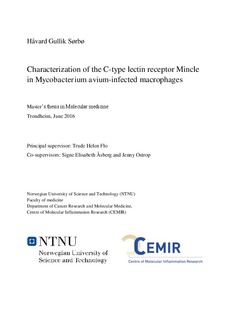| dc.description.abstract | Non-tuberculous diseases caused by opportunistic pathogens such as Mycobacterium avium are becoming more prevalent and has surpassed tuberculosis in developed countries. Trehalose6,6-dimycolate (TDM) is recognized by the C-type lectin receptor Mincle, it is an abundant glycolipid in the cell wall of mycobacteria and a major virulence factor. Yet, the role of Mincle in mycobacterial infection models has been reported controversially. It varies between mycobacterial species, and the role of Mincle in M. avium infection has not yet been assessed. Using a murine in vitro model, we found that wild type and Mincle-deficient bone marrowderived macrophages (BMMs) did not differ in their capability to phagocytose or kill M. avium, and no differences were observed for secreted amounts of KC, IL-6, IP-10 or G-CSF. The localization of Mincle and its trafficking during mycobacterial infection is still not fully elucidated. In order to being able to study the localization of Mincle during M. avium infection, we tested and established tools. FcRγ is essential for Mincle signalling and suggested to be required for surface localization of Mincle. In this study, FcRγ was found to be beneficial, but not essential for surface expression of Mincle in transiently transfected HEK293 cells, in line with previous research. Mincle-specific antibodies were identified by flow cytometry and its application confirmed also for confocal microscopy. Although antibodies were found to be specific in overexpressing HEK293 cells, some background was observed in Mincle-/- BMMs. Overexpression of tagged- and untagged Mincle in primary BMMs and bone marrow-derived dendritic cells was achieved by retroviral transduction. In HEK293 cells transiently transfected with Mincle + FcRγ, Mincle was localized to the plasma membrane and around the nucleus, while preliminary results from transduced primary BMM/DCs indicated a more outspread localization of Mincle. Preliminary results from transduced BMMs infected with M. avium did not indicate an increased concentration of Mincle around the phagocytosed mycobacteria. In summary, Mincle was not implicated to have an essential role in M. avium infection (≤ 5 d). While preliminary results indicated an outspread localization of Mincle in primary BMM/DCs, the tools established in this study can be used in future experiments to further elucidate the role Mincle upon mycobacterial infections. | nb_NO |
